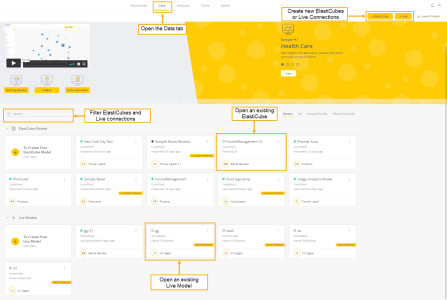Introduction to Data Models
This section describes data models in Sisense, how to connect to data sources, and how to avoid common mistakes when preparing your schemas.
Choosing a Data Model
In Sisense, there are three types of data models, ElastiCube models, Live models, and Hybrid models.
Designers create data and Live models to represent how data is brought into Sisense and how should it be used when supporting your dashboards. Which model you choose is determined by what you want to do with your dashboard. ElastiCube models tend to be faster when you are working with complex dashboards with large data sets, while Live models are preferred when you need near real-time updates. ElastiCube models and Live models can be used together in a single dashboard to support both use-cases. If you select a Hybrid model, you connect to Live data whilst also leveraging the power of ElastiCubes. This provides great flexibility without compromising performance.
From the Data tab, you can see a list of all the data models that you have created or that were shared with you.

For more information, see Navigating the Data Page
ElastiCubes
ElastiCubes are Sisense’s proprietary, high-performance analytical databases. They're specifically designed to withstand the extensive querying typically required for business intelligence applications. Import data from a variety of data sources into a Sisense ElastiCube, which becomes the database that supports your dashboard. Update your ElastiCube as the data in your sources change.
With ElastiCubes, you connect to your data sources, design your schema, and import your data (build). Sisense imports all of the relevant data from your sources into the ElastiCube.
The topics below describe ElastiCube s and how to model them.
- ElastiCubes
- Creating ElastiCubes
- Navigating the Model Editor
- Introduction to Data Sources
- Working with Data
- Transforming and Enriching Data
- Functions Overview
- Building ElastiCubes
- ElastiCube Build Settings
- ElastiCube Build Settings
Live Models
Unlike ElastiCube models, Live models run queries directly against the data source. Sisense doesn’t perform any additional caching on the data. This provides you with near real-time data updates in your dashboard, although Live connections rely on the source database for all queries. This means the queries are only as fast as the data source.
To create dashboards built on live connections to a data source, you create Live models. These data models include connection and credential details to the data sources. After you have created your live model, you publish it.
Publishing the live model adds it to your list of data models from which you can select when working with dashboards.
The topics below describe Live models, and how to create and publish them.
- Live Connect
- Creating Live Models and Adding Live Connections
- Working with Live Models
- Publishing Live Models
- Working with Live Models
Hybrid Models
The Hybrid model combines the best of ElastiCube and Live models. Hybrid models feed Live data into your dashboards while combining dashboards and analysis from historical data in the system. This means that, in Sisense, you can link your ElastiCubes to your Live data and work with them together, without reducing performance.
When you create a hybrid model, you add both ElastiCube and Live models to a single dashboard. For instructions on how to do this, see Creating a Dashboard with Multiple Sources.
.r.